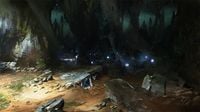Erosion: Difference between revisions
From Halopedia, the Halo wiki
NightHammer (talk | contribs) mNo edit summary |
Sith Venator (talk | contribs) No edit summary |
||
| Line 7: | Line 7: | ||
|location=Lunar pioneer site on [[Eudemon]] X49-05 | |location=Lunar pioneer site on [[Eudemon]] X49-05 | ||
|terrain=UNSC structures, large cave, swamp | |terrain=UNSC structures, large cave, swamp | ||
| | |gametypes= *[[Flood]] | ||
*[[Grifball]] | |||
| | |playernumber=2-12 | ||
}} | }} | ||
{{Article quote|Sites like this allow researchers the ability to closely observe a world's inner workings prior to colonization.}} | {{Article quote|Sites like this allow researchers the ability to closely observe a world's inner workings prior to colonization.}} | ||
Revision as of 18:57, July 13, 2014
Template:Multiplayer Map Infobox
| “ | Sites like this allow researchers the ability to closely observe a world's inner workings prior to colonization. | ” |
Erosion, also known as War Games Map_Set/: 773-9[1], is a Halo 4 multiplayer map intended for use as a cave themed Forge canvas. It is one of four such maps to be designed and adapted to Forging.[2]
Description
With hundreds of human colonies now razed in the wake of the Covenant War, the UNSC has dispatched large numbers of advanced pioneer groups to survey potential new worlds. The discovery of Eudemon X49-05 was considered lucky, but concerns remain about the moon’s structural integrity.[3]
Gameplay
Erosion is set in an expansive cave system, including a large watery area inside. Part of the map serves as a Grifball arena. A human facility of unknown function resides here.[2]
Trivia
- It is possible to enter the inside of the "Rock Seastack" object on Erosion. This is not possible on other maps.
- Erosion's pallet has a drastic difference in texture from its fellow Forge Maps. Rather than being a clean white in color, Erosion's objects have a rusted and dirty texture, which is in context with the map.
- Erosion is often criticized for its uneven and sloped terrain that makes it difficult to Forge on.
Gallery
- Erosion.jpg
A human tower in Erosion.
Sources
